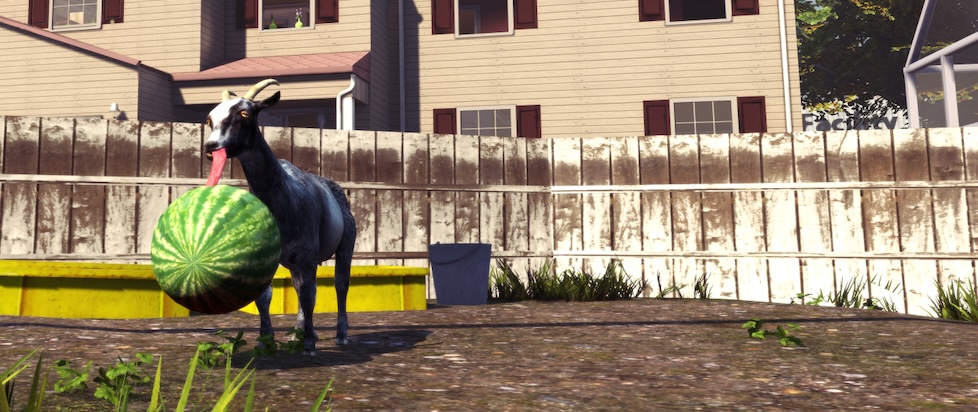
To Be a Wild Animal
As games become continually more complex and production companies aim to create increasingly captivating plots and heart-wrenching twists, a subgenre has taken hold of players – one that disregards the need for narrative altogether. Games such as Untitled Goose Game, Goat Simulator, and Squirrel with a Gun afford players a space to act as an unruly and lawless wild animal. The overall appeal of games such as these seems to be their nonsensical premises, and it is this nonsensicality that causes these games to diverge from other major genres. Players are quick to embrace the wild animal role that they are granted and dive into the chaos of the respective games.
Take Untitled Goose Game for example. It provides a brief exposition to the player that clearly explains the purpose of the game: “It’s a lovely morning in the village, and you are a horrible goose.” This contrast between the peaceful, picturesque village and the rude – perhaps even evil – nature of the goose persists throughout the game. The player assumes the role of a simple, white-feathered goose as it journeys through an English village, wreaking havoc along the way. Some of the tasks or actions that the goose takes are harmless; however, the overall purpose of the game is to complete a to-do list full of horrible tasks meant to terrorize, anger, frustrate, and annoy the villagers. This premise juxtaposes with the game’s cartoonish art style and classical music, thereby allowing the player to relax as they commit their reign of terror.
Goat Simulator and Squirrel with a Gun also fit within this tradition of the wild-animal subgenre and grant players a sandbox game through which they can play as – surprise, surprise – a goat or a squirrel. While Untitled Goose Game has a clear end goal of obtaining a bell and returning it to the pond, Goat Simulator and Squirrel with a Gun are a bit more open ended. These games provide an open space for the player to live out their wildest dreams of being an unruly animal with an unexplained vendetta against humankind. While these games have puzzles to solve and tasks to complete, their appeal lies in their freedom. In Goat Simulator, the player – as the title suggests – assumes the role of a goat and tries to cause destruction and chaos throughout a town. Squirrel with a Gun expands upon the premise put forth by traditional wild-animal games. In it, the player still assumes the role of a wild animal – this time, a rodent. However, in addition to being able to jump and climb, the squirrel also practices its second amendment rights by bearing arms. The game has a storyline that guides the player along, but its central focus remains its squirrely protagonist and its prowess for firearms.

Although these games lack clear, structured storylines with captivating narratives, they have been met with overall success. Untitled Goose Game has been a beloved game in the wild-animal subgenre, with an average rating of 10/10 on Steam. Goat Simulator and Squirrel with a Gun, while not as successful as their goosey contemporary, have also received high ratings, with both games holding an average 9/10 rating on Steam. All three games have been released on multiple platforms, and their widespread sales attest to their impact on the gaming community.
These games provide the opportunity to fight red in tooth and claw and to be a harbinger of chaos and terror. However, they are far from violent videogames. Rather, they couple their reign of terror with cutesy animation styles and nonsensical premises to create games that are silly and freeing from the constraints of other genres. The narratives for the games do not have to make sense – and they rarely do – because their driving force is the animal that the player gets to become rather than the story that they aim to tell. While other games grant players the chance to play as an animal, such as Maneater and Stray, they do not fit within the same wild-animal genre. These games do not encourage chaos and destruction. They instead invite the player to live a life as an animal in a more humanized – perhaps realistic – way. The wild-animal subgenre demands insanity. It asks the player to let go of their rigid ethic code and embrace their wild side.
Wild-animal games stand counter to popular AAA games that lean heavily into their dense plots, relatable characters, or high-definition graphics. By affording players the opportunity to don feather or fur, the wild-animal subgenre invites a casual and low-stakes gameplay; there is nothing grand at stake when playing as a feral animal. When players approach games like Untitled Goose Game, Goat Simulator, or Squirrel with a Gun, they can experience lighthearted fun. In a way, these games – though nonsensical and unrealistic – embody the essence of a videogame by offering excitement and interactivity. The chaos and destruction that is central to these games result in enjoyment for players and an utterly unforgettable experience.
———
Samantha Trzinski is a PhD candidate in English at The Ohio State University with a specialization in nineteenth-century British literature. She serves as a Contributing Editor with Gamers with Glasses and has also published in PopMatters.





